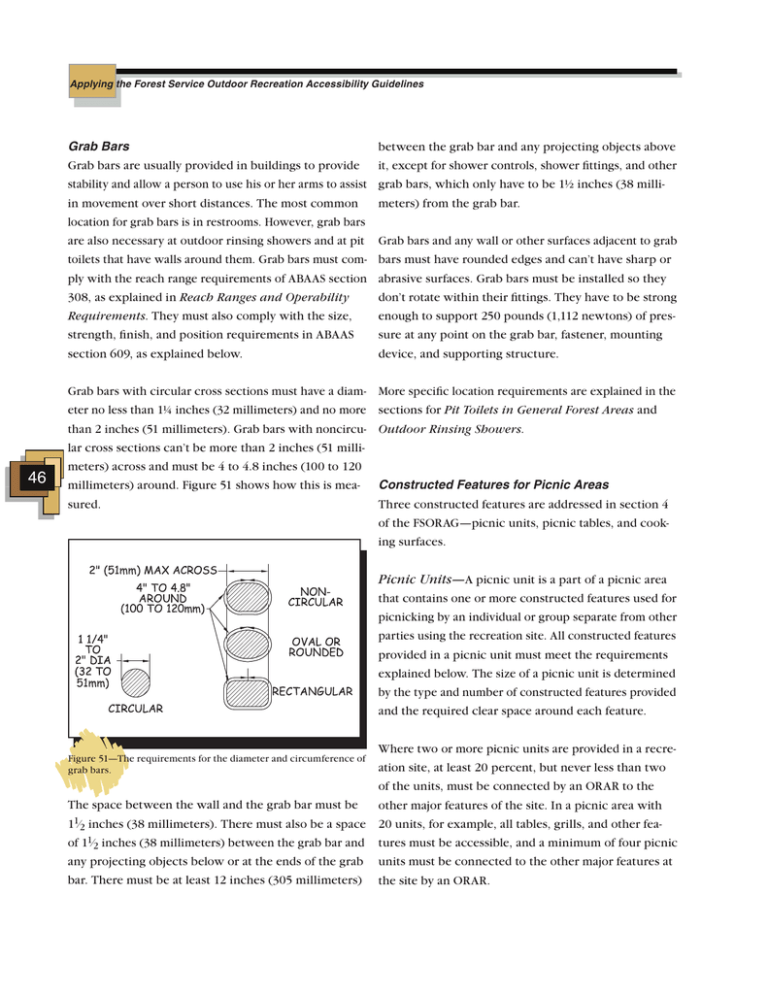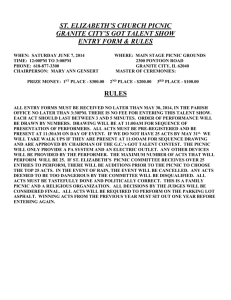Grab Bars between the grab bar and any projecting objects above
advertisement

Applying the Forest Service Outdoor Recreation Accessibility Guidelines Grab Bars Grab bars are usually provided in buildings to provide stability and allow a person to use his or her arms to assist in movement over short distances. The most common location for grab bars is in restrooms. However, grab bars are also necessary at outdoor rinsing showers and at pit toilets that have walls around them. Grab bars must comply with the reach range requirements of ABAAS section 308, as explained in Reach Ranges and Operability Requirements. They must also comply with the size, strength, finish, and position requirements in ABAAS section 609, as explained below. 46 Grab bars with circular cross sections must have a diameter no less than 1¼ inches (32 millimeters) and no more than 2 inches (51 millimeters). Grab bars with noncircular cross sections can’t be more than 2 inches (51 millimeters) across and must be 4 to 4.8 inches (100 to 120 millimeters) around. Figure 51 shows how this is measured. between the grab bar and any projecting objects above it, except for shower controls, shower fittings, and other grab bars, which only have to be 1½ inches (38 millimeters) from the grab bar. Grab bars and any wall or other surfaces adjacent to grab bars must have rounded edges and can’t have sharp or abrasive surfaces. Grab bars must be installed so they don’t rotate within their fittings. They have to be strong enough to support 250 pounds (1,112 newtons) of pressure at any point on the grab bar, fastener, mounting device, and supporting structure. More specific location requirements are explained in the sections for Pit Toilets in General Forest Areas and Outdoor Rinsing Showers. Constructed Features for Picnic Areas Three constructed features are addressed in section 4 of the FSORAG—picnic units, picnic tables, and cooking surfaces. Picnic Units—A picnic unit is a part of a picnic area that contains one or more constructed features used for picnicking by an individual or group separate from other parties using the recreation site. All constructed features provided in a picnic unit must meet the requirements explained below. The size of a picnic unit is determined by the type and number of constructed features provided and the required clear space around each feature. Where two or more picnic units are provided in a recreation site, at least 20 percent, but never less than two of the units, must be connected by an ORAR to the The space between the wall and the grab bar must be other major features of the site. In a picnic area with 1 1 ⁄2 inches (38 millimeters). There must also be a space 20 units, for example, all tables, grills, and other feaof 11⁄2 inches (38 millimeters) between the grab bar and tures must be accessible, and a minimum of four picnic any projecting objects below or at the ends of the grab units must be connected to the other major features at bar. There must be at least 12 inches (305 millimeters) the site by an ORAR. Figure 51—The requirements for the diameter and circumference of grab bars. Applying the Forest Service Outdoor Recreation Accessibility Guidelines The 20 percent requirement is a minimum. In the spirit and intent of universal design, designers are encouraged to connect as many units by an ORAR as is feasible, given the specific natural constraints of the site, the level of development, and other considerations. The FSORAG recognizes that the natural terrain often presents a real obstacle in the outdoor recreation environment. While terrain doesn’t affect the accessibility of the constructed features provided in the unit, it could make it difficult to provide an ORAR for the picnic unit. It may not be possible to provide an ORAR for all picnic units without affecting the fundamental nature of the picnic area and the recreation opportunity. Figure 52— At least two spaces must be accessible at a 10- to 18foot- (250- to 460- millimeter-) long picnic table. measured from the ground or floor to the bottom of the tabletop. Toe clearance of at least 9 inches (230 milliPicnic Tables—All picnic tables must comply with requirements for accessible seating spaces, table clear- meters) above the ground or floor must extend at least ance, slope, and surface. At least 20 percent of them must an additional 5 inches (25 millimeters) beyond the knee be connected by an ORAR to the other major constructed clearance. Figure 53 illustrates the required knee and toe features at the recreation area. This is the same as, not space. Toe clearance is required to ensure that someone in a wheelchair is able to sit close to the tabletop, regardin addition to, the ORAR connection requirement for picnic units. It is included here to ensure that everyone less of the design of the picnic table. If the table is constructed with one solid leg on each end, as opposed to understands that even if no constructed features are provided other than picnic tables, an ORAR connection an A-shaped frame or two individual legs on each end of the table that would allow the wheelchair to fit in is still required. The 20 percent requirement is only a minimum; designers are encouraged to connect more picnic tables where that is feasible. Picnic tables in GFAs don’t have to be connected to an ORAR. Wheelchair seating spaces must be provided based on the length of a picnic table (figure 52). For tables up to 9 feet (2.7 meters) long, one space is required. Tables between 10 feet (3 meters) and 18 feet (5.5 meters) long require two wheelchair spaces, and so on for longer tables. Knee space for wheelchair seating must be at least 30 inches (760 millimeters) wide, 19 inches (485 millimeters) deep, and 27 inches (685 millimeters) high, as Figure 53—The requirements for knee and toe space at a picnic table. 47 Applying the Forest Service Outdoor Recreation Accessibility Guidelines between, the toes of a person in a wheelchair would hit the table leg at the end of the 19-inch (485-millimeter) knee space. Without the additional 5-inch (25-millimeter) toe clearance, a person in a wheelchair wouldn’t be able to get close enough to the tabletop to use it comfortably. CONSTRUCTION TIP— Accessible picnic tables Picnic tables are tricky. Manufacturers often claim their tables are accessible even though they don’t meet accessibility requirements. The only sure way to know whether a table is accessible is to check the dimensions. 48 Figures 54, 55, and 56 show some examples of accessible tables that can be built by contractors or Forest Service crews. Use the links to view or save AutoCAD drawings of the tables. Clear floor or ground space that is 30 inches by 48 inches (760 millimeters by 1,220 millimeters) must be provided at each wheelchair seating space and must be positioned to accommodate a forward approach to the table (figure 57). No exceptions to the wheelchair seating space requirements are permitted. DESIGN TIP— Forward approach and side approach A forward approach means that the person is facing the object (figure 57). A side approach means that the person is beside the object (see figure 46). People need different-sized spaces to position their wheelchairs if they are in front of an object than if they are beside an object. This is why there are different clear floor or ground space requirements for forward and side approaches. Figure 54. Figure 55. Figure 57—The requirements for clear space at a picnic table. Figure 56. Figure 54, 55, and 56—Three examples of accessible picnic tables. Plans are on the Forest Service’s internal computer network at: http://fsweb.wo.fs.fed.us/eng/facilities/accrec/. In addition to the clear floor or ground space for each wheelchair seating space, a 48-inch (1,220-millimeter) clear floor or ground space is required around the usable portions of the table (figure 57). Table clearance is measured from the table seat out. Where a condition for departure exists, the table clearance may be reduced Applying the Forest Service Outdoor Recreation Accessibility Guidelines to 36 inches (915 millimeters). No other exceptions are no constructed features other than cooking surfaces are permitted. The clear space must be adjacent to the ORAR, provided, an ORAR connection is still required. The 20 but it may not overlap the ORAR. percent requirement is only a minimum; designers are encouraged to connect more cooking surfaces where it The slope of the required clear floor or ground space for is feasible. Connection to an ORAR isn’t required for wheelchair seating spaces and for table clearance can’t cooking surfaces, grills, and pedestal grills located in exceed 1:50 (2 percent) in any direction. An exception GFAs. is provided that permits a maximum slope of 1:33 (3 percent) where surface conditions require a steeper slope The height of the cooking surface must be 15 inches for proper drainage. The surface of the clear floor or (380 millimeters) to 34 inches (865 millimeters) above ground space must be firm and stable. The type of sur- the ground or floor surface. This is based on the height facing used should be appropriate to the setting and level for countertops and the minimum low forward reach of development. There are exemptions from the slope range in ABAAS. An exception clarifies that this height and surface requirements if a condition for departure range doesn’t apply to the grill attached to a fire ring exists. This is a particularly important exception for because the grill needs to be close to the fire for food to GFAs. cook properly. More information about fire ring requirements is available in Fire Rings, Fireplaces, and Wood Cooking Surfaces, Grills, and Pedestal Grills— Stoves. Requirements for accessible cooking surfaces, grills, and pedestal grills include cooking surface height, controls, CONSTRUCTION TIP— clear floor or ground space, slope, and surface. Figure Installing a pedestal grill 58 shows a typical pedestal grill. Each cooking surface, grill, and pedestal grill must comply with these provisions Most pedestal grills have adjustable cooking heights. and at least 20 percent of them must be connected to the If grills are installed so that the highest setting is other major constructed features at the recreation area 34 inches (865 millimeters) above the ground, users by an ORAR. This is the same as, not in addition to, the can lower the grill to a convenient height. ORAR connection requirement for picnic units. Even if Controls and operating mechanisms for cooking surfaces, grills, and pedestal grills must comply with the provisions for reach ranges and operability specified in ABAAS sections 308 and 309 and explained in Reach Ranges and Operability Requirements. A clear floor or ground space that is at least 48 inches Figure 58—The requirements for height, clear space, and reach range for a pedestal grill. (1,220 millimeters) deep and 48 inches (1,220 millimeters) wide, as measured from the cooking surface, must be provided around all usable portions of the cooking surface (figure 58). If a pedestal grill can rotate 360 degrees and all positions along that rotation are usable, 49 Applying the Forest Service Outdoor Recreation Accessibility Guidelines the 48-inch (1,220-millimeter) clear space must completely surround the grill. An exception permits the clear floor or ground space to be reduced to 36 inches (915 millimeters) if a condition for departure exists. The clear space must be adjacent to the ORAR, but it can’t overlap the ORAR. This clear space is required for safety. Restricted maneuvering room could increase the risk of getting burned. 50 The slope of the clear floor or ground space can’t exceed 1:50 (2 percent) in any direction. Where needed for proper drainage, an exception permits the slope to be up to 1:33 (3 percent) in any direction. The surface of the clear floor or ground space must be firm and stable, and the surface material used should be appropriate to the setting and level of development. As with the picnic table, there are exceptions from the slope and surface requirements if a condition for departure exists. This is particularly relevant where cooking surfaces, grills, and pedestal grills are installed in GFAs. Constructed Features for Campgrounds The FSORAG section 5 covers constructed features in campgrounds, including camping units, tent pads and platforms, fire rings, wood stoves, fireplaces, utilities, and utility sinks. Figure 59—The parts of a camping unit. Camp Living Areas—The surface of camp living areas must be firm and stable, and the surface material used should be appropriate to the setting and level of development. Where walk-in camping is provided in a campground, an ORAR must connect the camp living area to the parking spur or parking lot. Depending on the terrain and whether the work is new construction or alteration, this may mean that it won’t be possible to comply with the slope requirements for the ORAR to all walk-in units. Campground Parking Spurs—The parking spur is divided into two parts. The driveway is the section of the parking spur that provides vehicular access and a Camping Units—A camping unit is a part of a transition between the campground road and a vehicle campground that is used by an individual or group for parking area. The vehicle parking area is the section of camping separate from other parties using the the parking spur where camping vehicles (cars, vans, recreation site. A camping unit commonly includes the recreational vehicles, truck and trailer combinations, camp living area, a parking spur, and a space to pitch a and so forth) are parked. These definitions are important tent (figure 59). The camp living area is the space where because the scoping and technical provisions vary based tables, fire rings, and grills are located, and is often adja- on the specific part of the parking spur being addressed. cent to the parking spur. The FSORAG doesn’t require Figure 60 shows the parts of a parking spur. The surface a specific number or type of camp units or constructed of the entire parking spur must be firm and stable as features, but all camp units and constructed features explained in the section on Surfaces for ORARs. must meet FSORAG requirements. Applying the Forest Service Outdoor Recreation Accessibility Guidelines Figure 60—The components of a campground parking spur. Figure 61—An accessible RV with a lift. Each vehicle parking area that is adjacent to a camp living area must be at least 16 feet (4.8 meters) wide but the FSORAG also requires that some parking areas be 20 feet (6 meters) wide. To maximize accessibility while protecting the natural environment, only a limited number of vehicle parking areas must be 20 feet (6 meters) wide. The number of required 20-foot- (6-meter-) wide vehicle parking areas is based on the total number of camping units provided The 16-foot (4.8-meter) width is the same as the standard in the campground (table 2). width for an accessible parking stall for vans. An exception allows this width to be reduced to a minimum of Table 2—The number of 6-meter- (20-foot-) wide vehicle parking 13 feet (4 meters), the width of an accessible parking areas required in campgrounds of different sizes. space for cars, where a condition for departure exists. Minimum number Where the parking area can’t be made at least 13 feet of accessible recreational vehicle (4 meters) wide because of a condition for departure, a Number of camping units and trailer parking areas second exception allows construction of a narrower parking area. However, designers are strongly encouraged 1 1 to avoid constructing parking areas less than 13 feet (4 2 to 25 2 meters) wide. 26 to 50 3 A 16-foot- (4.8-meter-) wide parking area will accommodate cars, vans, and the majority of recreational vehicles (RVs) and trailers. However, an area that is 20 feet (6 meters) wide is required for full-size accessible RVs (figure 61) and trailers. This width is required to accommodate lifts, ramps, and other assistive equipment that allow RV owners to enter, exit, and move around all sides of the vehicle. The dimensions are based on a 8-foot(2.4-meter-) wide vehicle, an 8-foot- (2.4-meter-) wide space on the passenger side for operation of the lift or ramp with room to maneuver, and a 4-foot- (1.2-meter-) wide clear space along the driver’s side. 51 to 75 4 76 to 100 5 101 to 150 7 151 to 200 8 201 to 300 10 301 to 400 12 401 to 500 13 501 to 1,000 2 percent of total 1,001 and over 20 plus 1 for each 100 over 1,000 51



